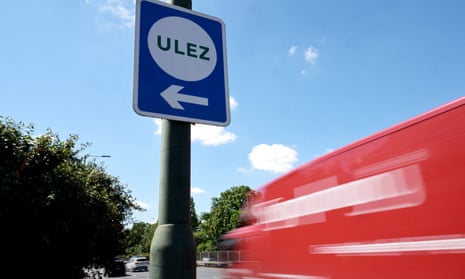The controversial expansion of London’s ultra-low emission zone (Ulez) on Tuesday will be watched closely by policymakers around the UK and the world, as other cities weigh up whether to introduce similar schemes.
One key question is whether low-emission zones make financial sense for cities that introduce them. City administrations must weigh up the health benefits, any income from tolls and fines, the positive and negative effects on businesses and the cost to affected residents.
Since its initial rollout in 2019, the existing Ulez – which covers central London – has reduced nitrogen oxide and nitrogen dioxide emissions across the whole city by 23%, according to the London mayor’s office.
An analysis by the University of York found that Ulez, the congestion charge introduced in 2003 and the less strict low emission zone covering all of London, introduced in 2008, had reduced the probability of long-term health conditions by 22.5%, other health conditions by 29.8% and the amount of sick leave taken by 17.7%.
One of the key questions for policymakers is whether the health benefits of such schemes translate into broader economic gains. Research commissioned by Transport for London (TfL) and the Greater London Authority has forecast that London’s clean-air policies will save the city’s NHS and social care system about £5bn by 2050. The study also found that if action is not taken, the cost of air pollution to health and social care will be about £10.4bn by the same year.
Businesses stand to benefit from better air quality. Air pollution is responsible for more than 6 million sick days in the UK every year, and research from the World Green Building Council suggests that better air quality increases workers’ productivity by 8-11%.
However, some small business owners have questioned the expansion, saying that the daily fees or the need to buy new vehicles will cost too much. In a recent poll, 39% of business owners in outer London and 29% in inner London said they were worried about the Ulez expansion having a negative effect on their workers, despite the mayor’s £110m scrappage scheme and a six-month “grace period” for which they can apply.
Some opponents of the Ulez expansion have described the scheme as a revenue-raising exercise for TfL. In the 2021-22 financial year, TfL earned earned £226m from the scheme. The net revenue generated from Ulez is reinvested back into inner and outer London’s transport networks, which is likely to make sustainable modes of transport more appealing, further lightening the burden of pollution caused by motor vehicles.
Other cities have done the same. Birmingham city council has used the £52m it has raised from low-emission zones to invest in hydrogen bus trials, railway stations and cycling routes, while Bristol has provided grants and loans to help the switch to low-emission vehicles.
In a letter to the London mayor, Sadiq Khan, the Builders Merchant Federation expressed concerns that Ulez expansion would make some tradespeople reluctant to attend jobs within the zone. John Newcomb, boss of the trade body, said: “This will have a knock-on effect for end customers, who will find it more difficult and costly to get work done.”
However, research has shown consumers spend less on days where there is poorer air quality, and a Yale study found Spanish consumers spent €25m-€41m less on days where pollution was 10% worse than usual.
Prof Lorraine Whitmarsh, an environmental psychologist and director of the Centre for Climate Change and Social Transformations (Cast), says: “While Ulez schemes are providing an important ‘stick’ to discourage car use, they may not be providing enough of a ‘carrot’ to enable some groups to shift transport modes.”
Recent research by Cast found sociodemographic factors played a large part in people’s opinions. Low-income groups were more likely to be opposed to the policy, whereas people with children were more in favour.
after newsletter promotion
“Since fairness is a key driver of policy acceptance, Ulez opposition may be due to the perception that the scheme is unworkable, or unfair for those with older vehicles. Low-income groups, nevertheless, are most likely to benefit in general from Ulez since they tend to live in areas with greatest air pollution.”
Dr Audrey de Nazelle, a senior lecturer at the Centre for Environmental Policy at Imperial College London, says drastic changes are necessary both for air pollution and climate change.
“Ulez will contribute to this and is part of the solution, but far more than Ulez needs to be done.
“People need to be engaged towards far more transformative solutions than just having to buy another car. By explaining the multiple benefits and creating a common vision of what a desirable city might look like we’re more likely to make these solutions politically feasible for the benefit of all.”
Khan has weighed up the financial case for Ulez against the political cost and decided to press ahead with its expansion. How it is received in the next few weeks is likely to determine which other cities decide to follow suit.
